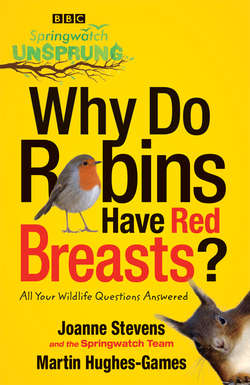Читать книгу Springwatch Unsprung: Why Do Robins Have Red Breasts? - Jo Stevens - Страница 12
Shenanigans in the Shrubbery
ОглавлениеCan you explain a strange behaviour we’ve recently witnessed? Dunnocks live in our pyracantha hedge by our back door and feed and drink below it. One dunnock, presumably female, stands still and presents its rear end – tail erect and feathers well fluffed up – and allows its partner to gently peck its bottom repeatedly. This happens time and time again. Is this birdie foreplay? Mr and Mrs H
Behind the dull grey and brown plumage of the dunnock (also known as a hedge sparrow, though it’s not a sparrow at all) lies a story of sexual intrigue and behaviour worthy of any soap opera. Their name means ‘little brown one’ but this shy, reclusive bird has a rather colourful and promiscuous lifestyle.
In most species of birds, monogamy is the norm – at least on the surface, though quite a few will skulk off for what are quaintly called ‘extra-pair copulations’. Dunnocks, however, have evolved a system where infidelity is par for the course. They use various mating strategies, including love triangles and secret affairs as well as good, old-fashioned monogamy.
Some females breed with two (or more) males, which is a relationship known as polyandry. She mates with both simultaneously, often producing a brood with mixed paternity. By being promiscuous, the female is maximising the chances of her chicks surviving because both fathers will bring food to the nest. Each father will adjust his feeding rate according to how exclusive his relationship was with the mother – the more matings he had, the more likely he is to be the father and the more food he will provide for the nestlings.
Some males will mate with several females (polygyny) and there are even more complicated arrangements among several males and females (polygynandry). A male does best by mating with several females while a female is better off with several male partners. Clearly, this may lead to a battle of the sexes, with males and females competing for the greatest reproductive success.
The specific relationships that occur in each area appear to be determined by several factors. Firstly, the sex ratio in the population may be skewed after a harsh winter to have more males than females – males outcompete females for food so the females are less likely to survive. Secondly, areas with dense bushes allow the females to sneak off for ‘a bit on the side’ more easily. Lastly, each male and female defends its own territory, and if food is scarce the territories need to be larger. The bigger the females’ territories are, the harder it is for a male to monopolise mating rights to more than one female. Where food is plentiful, females’ territories are more compact and a male has a better chance of patrolling them and successfully seeing off any rivals.
These sneaky sexual shenanigans lead to some interesting courtship behaviour. In a sense, what the Hanhams witnessed was foreplay. By presenting her rear end and twirling her tail coquettishly the female is inviting the male to mate with her. The male, however, wants to ensure his paternity so he pecks at the female’s cloaca (her genital opening) to make her eject any sperm from previous matings. He may continue pecking at her for several minutes until he’s satisfied that she has got rid of any other male’s sperm and he can be sure that it will be his genes making it through to the next generation. The male may spend a huge amount of time trying to guard his female and protect his paternity rights by preventing her mating with other males. Despite his best efforts, the female will regularly escape as soon as his back is turned and solicit matings from his rivals. Mating activity can become quite frenzied, the avian equivalent of a Benny Hill sketch. Males may mate up to 100 times a day, but blink and you’ll miss it – the action is all over in just a tenth of a second.
